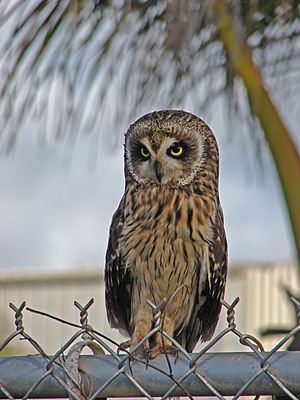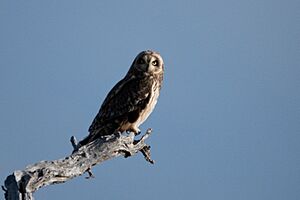Pueo facts for kids
Quick facts for kids Pueo |
|
|---|---|
 |
|
| Conservation status | |
| Scientific classification |
|
| Kingdom: | Animalia |
| Phylum: | Chordata |
| Class: | Aves |
| Order: | Strigiformes |
| Family: | Strigidae |
| Genus: | Asio |
| Species: |
A. flammeus
|
| Subspecies: |
A. f. sandwichensis
|
| Trinomial name | |
| Asio flammeus sandwichensis A. Bloxam, 1827
|
|
| Synonyms | |
|
|
The pueo (Asio flammeus sandwichensis) is a subspecies of the short-eared owl and is native to Hawaii.
Taxonomy
This taxon was first named by Andrew Bloxam (as the species Strix sandwichensis). He saw it, although did not collect a specimen, while in the Hawaiian Islands in 1825 as the naturalist on board HMS Blonde. It is now considered to be a subspecies of the short-eared owl, Asio flammeus, although Storrs Olson did not consider it to be distinct from Asio flammeus flammeus.
Description
The bird has long wings and a short tail. Its plumage can be of different shades of brown and gray. Pueo are 13 to 17 inches in length. One of the bird's distinctive features is its striking yellow eyes.
Distribution and population
The pueo inhabits forests and grasslands throughout the Hawai’i archipelago.
Recent surveys suggest that their population is declining, specifically on Oʻahu, an island where they were once quite common. The pueo is currently listed as an endangered species.
Diet
Its diet consists of small mammals, such as mice, rats, and rabbits, which they can expertly detect from far distances with their large eyes. They hunt mostly at night as their incredibly advanced nocturnal vision enables them to fly through densely wooded areas with ease. As soon as a prey animal is spotted by the pueo, the owl intently glides-over and lands directly on top of it, killing it instantly before flying away, without a sound. The pueo can also feed on insects and reptiles.
History
The pueo is thought to have colonized Hawai’i after the arrival of the Polynesians. This relatively recent arrival of the pueo in Hawai’i may be linked to Polynesian rats (Rattus exulans), which were brought to the islands by humans.
Threats to survival
Pueo nest on the ground, which makes their eggs and young susceptible to predation by the introduced small Indian mongoose and other predators.
Pueo are strongly affected by light pollution. They are often killed in vehicular accidents.
SOS
Pueo appear to be somewhat resistant to the avian malaria that has devastated many other endemic bird populations in Hawaii; however, they have recently become victim to an unknown mysterious "sick owl syndrome", or SOS, in which large numbers of pueo have been found walking dazedly on roads, leading to death by collision. The cause of sick owl syndrome is unknown; it is suspected that pesticide toxicity may be responsible, particularly through secondary rodenticide poisoning. However, it has also been hypothesized that the cause may be an infectious agent, seizure-like confusion due to light pollution, or a variety of other causes.




